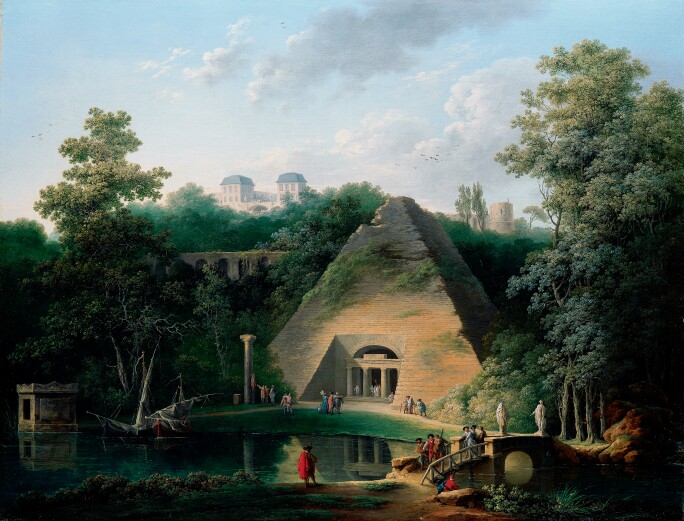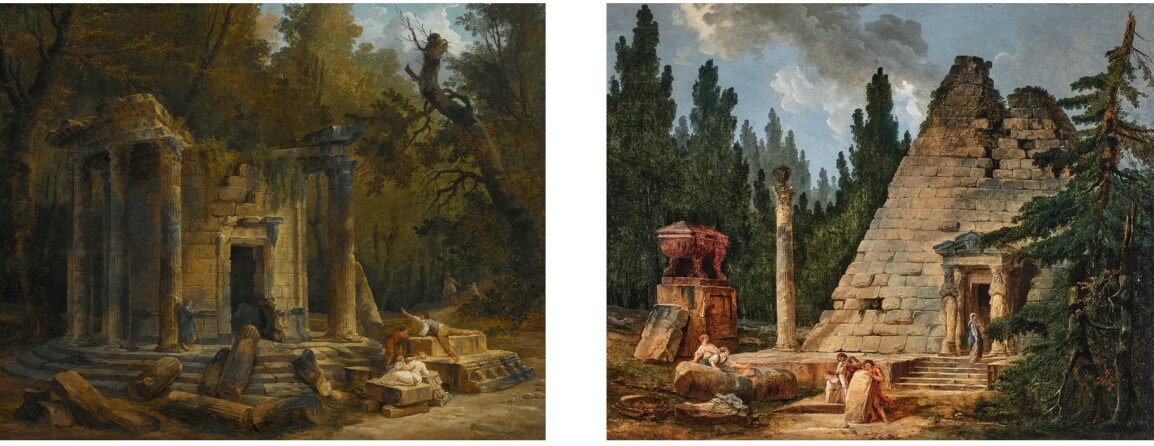H
ubert Robert was the pre-eminent French landscape painter of the late eighteenth century, training for over a decade in Rome before establishing himself at the center of the Parisian art world upon his return to the city in 1765. During his early years, Robert developed what would be a life-long fascination with architecture and his many depictions of ruins earned him the sobriquet “Robert des Ruines.” By the time the artist returned to Paris, he was already successful and well-known. He was accepted as a member of the Academy in 1766 and, in 1778, was appointed designer of the King’s gardens and given lodgings in the Louvre. He exhibited regularly at the Salons until 1797 and completed countless commissions for the nobility, aristocracy and foreign dignitaries throughout his career. He was renowned for his landscapes featuring ancient ruins and beautiful gardens, often incorporating both known and fantastical architectural elements in his compositions.
This impeccably preserved and mature work by Robert beautifully captures his enchantment with both Ancient Egypt and the architectural ruins. In it, he depicts the real pyramid which was erected in the gardens of the castle at Maupertuis, in the east of Paris, by the marquis de Montesquiou. Designed by the architect Alexandre Brongniart, the pyramid was built between 1775 and 1780, though Robert's painting dates to 1798. Robert himself was a landscape designer, and likely assisted Brongniart and the architect Claude-Nicolas Ledoux with the design of certain aspects of Montesquiou's estate. Indeed Robert and Montesquiou were close, with the latter commissioning a pair of Roman capricci from the artist in 1784.1

Though it was recently built, Robert painted the pyramid in a style that evokes an ancient ruin, harkening back to his favorite Italian subject matter. He also allowed himself certain liberties, changing the way the doorway worked and adding a set of stairs and terrace to enhance the composition. In real life there is a pond outside the front of the pyramid, but he has omitted it in order to allow space for the figures in the foreground, creating a harmonious and lively scene. Though the column is similar to the original, the funerary monument to its left is quite different. A painting of the pyramid at Maupertuis by Claude-Louis Chatelet (fig. 1), which follows the garden's design in a more faithful and classical manner, allows us insight into creativity that Robert infused into his composition.2

Right: The Present Lot.
This painting was previously in the Bruni-Tedeschi collection with a pendant that depicted the Temple at Ermenonville, another antique-style building set into a French garden that was designed in collaboration with Robert (fig. 2).
1 Now in the Musée du Louvre, inv. nos. 7636 and 7637.
2 Previously in the collection of Karl Lagerfeld and sold New York, Christie's, 23 May 2000, lot 72.